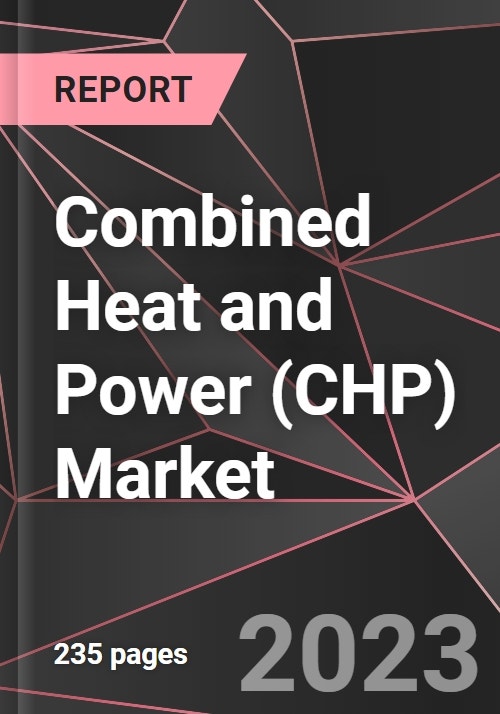Micro Combined Heat and Power (Micro CHP) Market Size – Market.us

Micro Combined Heat and Power (Micro-CHP) Market: A Report on Sustainable Energy Integration
Executive Summary
The global Micro Combined Heat and Power (Micro-CHP) market is on a significant growth trajectory, projected to expand from USD 3.8 billion in 2024 to USD 10.2 billion by 2034, reflecting a Compound Annual Growth Rate (CAGR) of 10.4%. This expansion is fundamentally linked to the global pursuit of the United Nations’ Sustainable Development Goals (SDGs), particularly SDG 7 (Affordable and Clean Energy), SDG 11 (Sustainable Cities and Communities), and SDG 13 (Climate Action). Micro-CHP systems, which generate heat and electricity simultaneously from a single fuel source, offer a decentralized and highly efficient energy solution. By capturing waste heat, these systems drastically improve energy efficiency compared to conventional power generation, directly contributing to reduced carbon emissions and advancing climate action objectives.
Market growth is driven by the increasing demand for energy resilience, cost savings, and lower environmental footprints. As a decentralized technology, Micro-CHP enhances local energy security and supports the development of sustainable infrastructure, a core tenet of SDG 11. Government incentives and regulations favoring distributed generation further accelerate adoption. The residential sector remains the primary application area, underscoring the technology’s role in creating energy-efficient and sustainable households. The Asia-Pacific region leads the market, driven by strong government programs aimed at promoting clean energy and sustainable urbanization.
Alignment with Sustainable Development Goals (SDGs)
The Micro-CHP market is intrinsically aligned with several key SDGs:
- SDG 7: Affordable and Clean Energy: Micro-CHP provides a direct pathway to more efficient and cleaner energy at a localized level. By maximizing fuel use, it reduces energy waste and can lower costs for consumers, improving access to affordable energy.
- SDG 11: Sustainable Cities and Communities: The technology supports the creation of resilient and sustainable communities by offering a decentralized power source that is less vulnerable to large-scale grid failures. Its application in residential and commercial buildings helps reduce the overall carbon footprint of urban areas.
- SDG 13: Climate Action: The primary environmental benefit of Micro-CHP is its high efficiency, which leads to a significant reduction in greenhouse gas emissions compared to separate heat and power generation. This makes it a critical technology in the global effort to combat climate change.
- SDG 9: Industry, Innovation, and Infrastructure: The ongoing development of Micro-CHP technologies, including fuel cells and advanced Stirling engines, represents significant innovation in sustainable energy infrastructure.
Market Analysis and Key Findings
- Market Growth: The market is forecast to reach USD 10.2 billion by 2034, driven by the global push for energy efficiency and decarbonization in line with SDG 13.
- Dominant Capacity: Systems with a capacity of 2 kW to ≤ 10 kW held a 56.3% market share in 2024, ideal for residential applications that support sustainable household energy consumption (SDG 11).
- Preferred Fuel Source: Natural gas and LPG constituted 62.4% of the market share, valued for their cleaner combustion and established infrastructure, serving as a transitional fuel source towards the goals of SDG 7.
- Leading Technology: Stirling engine technology accounted for 38.7% of the market, favored for its fuel flexibility, quiet operation, and high efficiency, which contributes to achieving climate targets under SDG 13.
- Primary Application: The residential segment dominated with a 69.1% share, highlighting the technology’s importance in advancing energy efficiency at the household level.
- Regional Leader: The Asia-Pacific region commanded 44.70% of the market, with a value of USD 1.6 billion, due to strong policy support for clean energy and sustainable urban development.
Market Segmentation Analysis
Analysis by Capacity
In 2024, the 2 kW to ≤ 10 kW capacity segment held a commanding market share of 56.3%. This dominance is attributed to the segment’s suitability for residential and small commercial buildings, where it effectively balances heat and power demands. The adoption of these systems directly supports SDG 11 by enabling the development of energy-efficient housing and sustainable communities. Rising energy costs and government incentives promoting decentralized generation further propel this segment’s growth, aligning with the objective of providing affordable and clean energy (SDG 7).
Analysis by Fuel Type
Natural Gas and LPG-fueled systems accounted for 62.4% of the market in 2024. The widespread availability of natural gas infrastructure and the cleaner combustion properties of these fuels compared to coal or oil make them a preferred choice. This preference aligns with near-term goals for emissions reduction under SDG 13. While these fuels are transitional, their efficiency in Micro-CHP systems provides a significant improvement over traditional energy sources, contributing to a cleaner energy mix as the world moves towards fully renewable solutions envisioned in SDG 7.
Analysis by Prime Mover Technology
The Stirling engine segment led the market with a 38.7% share in 2024. Its high efficiency, low noise, and fuel versatility make it an ideal prime mover for residential settings. The technology’s ability to operate with low emissions supports climate action goals (SDG 13). Continuous innovation in Stirling engine design, aimed at improving durability and reducing costs, contributes to SDG 9 by fostering advancements in sustainable industrial technology.
Analysis by Application
The residential sector was the largest application segment, with a 69.1% market share. This reflects a growing consumer awareness of energy efficiency and a desire for cost savings and energy independence. The deployment of Micro-CHP in homes is a critical step towards building sustainable communities (SDG 11) from the ground up. By empowering homeowners with cleaner energy solutions, this trend directly advances the accessibility of modern, reliable energy as outlined in SDG 7.
Market Dynamics
Market Drivers
The primary driver for the Micro-CHP market is the increasing global demand for efficient, decentralized energy systems. This demand is a direct response to the objectives of the SDGs, particularly the need for reliable, sustainable, and modern energy for all (SDG 7). Micro-CHP systems enhance energy efficiency by utilizing waste heat, thereby reducing fuel consumption and greenhouse gas emissions (SDG 13). Furthermore, as decentralized units, they bolster grid resilience and contribute to the development of sustainable and resilient infrastructure in cities and communities (SDG 11).
Market Restraints
High initial installation and maintenance costs remain a significant barrier to widespread adoption. The upfront investment required for a Micro-CHP system can be prohibitive for many residential and small commercial users. This financial barrier impedes the equitable distribution of clean energy technology, potentially slowing progress towards the universal access goals of SDG 7. Overcoming this restraint requires innovation in manufacturing and supportive financial mechanisms to make the technology more accessible.
Market Opportunities
A substantial growth opportunity lies in integrating Micro-CHP systems into sustainable community energy projects. These initiatives, focused on creating low-carbon and energy-efficient communities, align perfectly with SDG 11. Micro-CHP can serve as a foundational technology for local energy grids, providing efficient heat and power to residential clusters, public facilities, and commercial buildings. Such projects demonstrate a scalable model for sustainable urban development and climate-resilient infrastructure.
Emerging Market Trends
A key trend is the convergence of Micro-CHP with smart energy solutions. The integration with smart grids, digital monitoring platforms, and energy management systems allows for the optimization of performance, maximizing efficiency and further reducing emissions. This trend reflects progress under SDG 9 (Industry, Innovation, and Infrastructure) and enhances the technology’s contribution to building smart, sustainable cities (SDG 11) and combating climate change (SDG 13).
Regional Market Analysis
In 2024, the Asia-Pacific region dominated the global Micro-CHP market with a 44.70% share. This leadership is a result of strong government policies in countries like Japan and China that promote energy efficiency and decentralized power to address rapid urbanization and reduce carbon emissions. These efforts are directly aligned with achieving SDG 11 and SDG 13. North America and Europe are also significant markets, driven by stringent environmental regulations and incentives for low-carbon technologies. The gradual adoption in Latin America and the Middle East & Africa indicates a growing global recognition of Micro-CHP’s role in achieving a sustainable energy future.
Key Regions
- North America
- Europe (Germany, UK, France, Spain, Italy)
- Asia Pacific (China, Japan, India, South Korea)
- Latin America
- Middle East & Africa
Competitive Landscape
Key players in the Micro-CHP market are focusing on innovation to enhance efficiency and reduce emissions, directly contributing to SDG targets. Companies like Viessmann Group are developing high-efficiency units with advanced control systems to optimize energy use. Axiom Energy Group, LLC. focuses on modular designs for flexibility, while EC Power A/S specializes in scalable systems for urban environments. These corporate strategies underscore an industry-wide commitment to advancing sustainable energy transformation in line with global goals.
Leading Market Participants
- Viessmann Group
- Axiom Energy Group, LLC.
- EC Power A/S
- Yanmar Holdings Co. Ltd.
- Vaillant Group
- SOLIDpower Group
- Remeha
- 2G Energy Inc.
- ATCO Ltd
- Enginuity Power Systems
Analysis of Sustainable Development Goals in the Micro CHP Market Article
1. Which SDGs are addressed or connected to the issues highlighted in the article?
-
SDG 7: Affordable and Clean Energy
The article’s central theme is the Micro Combined Heat and Power (Micro-CHP) market, a technology designed to produce heat and electricity efficiently from a single fuel source. This directly relates to ensuring access to affordable, reliable, and modern energy. The text highlights how Micro-CHP systems “achieve much higher overall energy efficiency” and are driven by a need to “reduce costs” and use “cleaner combustion” fuels like natural gas and LPG.
-
SDG 9: Industry, Innovation, and Infrastructure
The article discusses the development and adoption of innovative energy technology (Micro-CHP) and the infrastructure supporting it. It points to “advancements in compact engine and fuel cell technologies,” the integration of Micro-CHP with “smart grids,” and the role of decentralized systems in areas with “weak centralized infrastructure.” This aligns with SDG 9’s goal of building resilient infrastructure and fostering innovation.
-
SDG 11: Sustainable Cities and Communities
The growth of Micro-CHP is linked to making human settlements more sustainable. The article mentions its application in “residential and small commercial applications,” its role in “sustainable community energy projects,” and its contribution to “sustainable urban development.” By providing efficient, decentralized energy, Micro-CHP helps reduce the environmental impact of buildings and communities.
-
SDG 13: Climate Action
The article explicitly connects the adoption of Micro-CHP technology to climate action goals. It states that users seek to “lower carbon footprints” and that the technology aligns with “ongoing efforts to reduce emissions.” The trend towards “low-carbon and smart energy solutions” and achieving “carbon neutrality” is presented as a key driver for the market, directly supporting the objectives of SDG 13.
2. What specific targets under those SDGs can be identified based on the article’s content?
-
Target 7.3: Double the global rate of improvement in energy efficiency.
The core function of Micro-CHP is to improve energy efficiency. The article states that these systems “recover waste heat that would otherwise be lost” and “make fuller use of fuel input.” The entire market growth, projected at a CAGR of 10.4%, is predicated on the demand for higher efficiency to save costs and reduce waste, directly contributing to this target.
-
Target 9.4: Upgrade infrastructure and retrofit industries to make them sustainable, with increased resource-use efficiency and greater adoption of clean and environmentally sound technologies.
Micro-CHP is presented as a “cleaner,” “low-carbon,” and “efficient” technology being adopted in residential and commercial buildings. The article’s discussion of “decentralized energy generation” and integrating these systems into “smart grids” represents an upgrade to traditional energy infrastructure, aligning with the goal of adopting sustainable and efficient technologies.
-
Target 11.6: Reduce the adverse per capita environmental impact of cities.
The article highlights that the residential segment dominates the market with a 69.1% share, driven by a need to “reduce electricity bills” and “lower carbon footprints.” By improving energy efficiency at the household and community level, Micro-CHP systems directly contribute to reducing the overall environmental impact of urban and residential areas.
-
Target 13.2: Integrate climate change measures into national policies, strategies and planning.
The article identifies “Strong government energy programs,” “incentives,” “strict emission regulations,” and “policy support” as key drivers for the Micro-CHP market. These examples, such as the “₹30,000 cr LPG relief package,” show how governments are integrating climate-friendly energy policies to encourage the adoption of low-emission technologies.
3. Are there any indicators mentioned or implied in the article that can be used to measure progress towards the identified targets?
-
Market Growth and Investment in Efficient Technologies:
The article provides clear financial data that can serve as an indicator of progress. The market’s growth from “USD 3.8 billion in 2024” to a projected “USD 10.2 billion by 2034” at a “CAGR of 10.4%” indicates an increasing rate of adoption of energy-efficient technology (relevant to Target 7.3). Furthermore, specific investments like “Falcon Corporation securing EUR 21 million” and “Zeno Power raising $50 M” quantify the financial commitment to developing and scaling these technologies (relevant to Target 9.4).
-
Adoption Rate in Key Sectors:
The article provides market share data that indicates where adoption is occurring. The fact that the “residential segment dominated the micro CHP market with a 69.1% share” serves as a direct indicator of the technology’s penetration into communities, which is crucial for measuring progress towards reducing the environmental impact of cities (Target 11.6).
-
Share of Cleaner Fuels:
The article states that “Natural gas and LPG accounted for a 62.4% share” in the market because they offer “cleaner combustion.” This percentage can be used as an indicator to track the shift away from more polluting fuels like coal and oil (also listed as fuel types) towards cleaner energy sources, which is a measure of progress in energy efficiency and climate action (Targets 7.3 and 13.2).
-
Government Policies and Financial Support:
The mention of “strong policy support,” “government initiatives,” and specific financial packages like the “₹30,000 cr LPG relief package” and “£2 million… to help safeguard Scotland’s historic environment” are qualitative and quantitative indicators of how climate change measures are being integrated into national and local planning (Target 13.2).
4. Summary Table of SDGs, Targets, and Indicators
| SDGs | Targets | Indicators |
|---|---|---|
| SDG 7: Affordable and Clean Energy | 7.3: Double the global rate of improvement in energy efficiency. |
|
| SDG 9: Industry, Innovation, and Infrastructure | 9.4: Upgrade infrastructure and adopt clean and environmentally sound technologies. |
|
| SDG 11: Sustainable Cities and Communities | 11.6: Reduce the adverse per capita environmental impact of cities. |
|
| SDG 13: Climate Action | 13.2: Integrate climate change measures into national policies, strategies and planning. |
|
Source: market.us

What is Your Reaction?
 Like
0
Like
0
 Dislike
0
Dislike
0
 Love
0
Love
0
 Funny
0
Funny
0
 Angry
0
Angry
0
 Sad
0
Sad
0
 Wow
0
Wow
0














































.jpg.webp?itok=0ZsAnae9#)







:focal(1500,1000)/https://media.globalcitizen.org/a6/9a/a69a4720-d8a1-4715-b596-18738d03c05c/rotary_polio_hero_image.jpg?#)

/countries/sri-lanka/photo-credit---dmc-sri-lanka.tmb-1200v.jpg?sfvrsn=dc298bcc_1#)


















